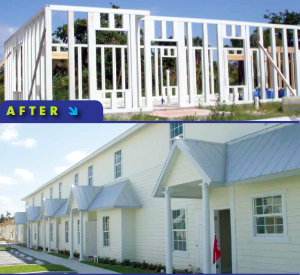Everybody’s talking about it: the coming of new technologies, such as 3-D printing, robotics and carbon nanotubes, that will have a profound impact on the built environment. As just one example, imagine a 3-D printer capable of producing the most intricate historic profiles for mouldings and textured surfaces at a degree of complexity never before imagined or simply eliminating the need to keep large stores of spare parts. When you need a part, you just make one by scanning a QR code or looking up the part number in the cloud and hitting the print button on your 3-D printer. There are even plans to print whole buildings. In fact, 3-D printing, robotics and carbon nanotubes are already being deployed into the markets where their functional and other advantages make them economically viable. But, of course, these technologies will face unforeseen hurdles and opportunities.

materials and meets requirements for a hurricane zone.
Guessing what will win in the marketplace in the future is often a fool’s errand, but it is useful to keep a watchful eye on what is happening, especially with technology that is maturing quickly or is market disruptive. Because the retrofit market is one of the largest sectors of the building industry, it should come as no surprise that many of the most viable and useful applications will be for existing buildings. One fascinating technology example is Fort Myers, Fla.-based Composite Building Structures Ltd., a company that has created a whole new building system by adapting a known technology called pultrusion, which combines glass fibers and resin, to meet the framing needs of the residential and commercial markets.
Known Technology, New Applications
Pultrusion operates by pulling material though a mold to create a product rather than the more commonly known “extrusion,” which pushes heated material through a die. Pultruded product types already are used in various industries, including aerospace and aviation (the Boeing Dreamliner’s wing design is an example, though the fibers are very expensive carbon fibers), automotive and infrastructure.
Pultrusion and materials made out of glass fibers and resin have a long history and have design and structural information available. The Washington, D.C.-based American National Standards Institute and other industry organizations have produced numerous standards or are in the process of delivering standards dealing with the use of pultruded fiber-reinforced polymers.
The best-known application of pultrusion in the construction industry is probably super-strong ladder rails or hammer handles. Meanwhile, CBS is the first to create proprietary framing and panel solutions for residential and commercial construction. The CBS material is a composite made of glass fibers embedded in a modified polyurethane resin that provides attractive physical attributes with costs comparable to wood or concrete block. Unlike fiberglass that has short fibers, the glass fibers here run from end to end and are continuous in the product. In essence, they are like bundles of many thousands of fishing lines catalyzed together in a resin base. This is what gives the material its unique properties.


1 Comment
Innovation is inevitable construction materials will change architecture. Elements in design will not relate to location. Buildings will reflect technology.